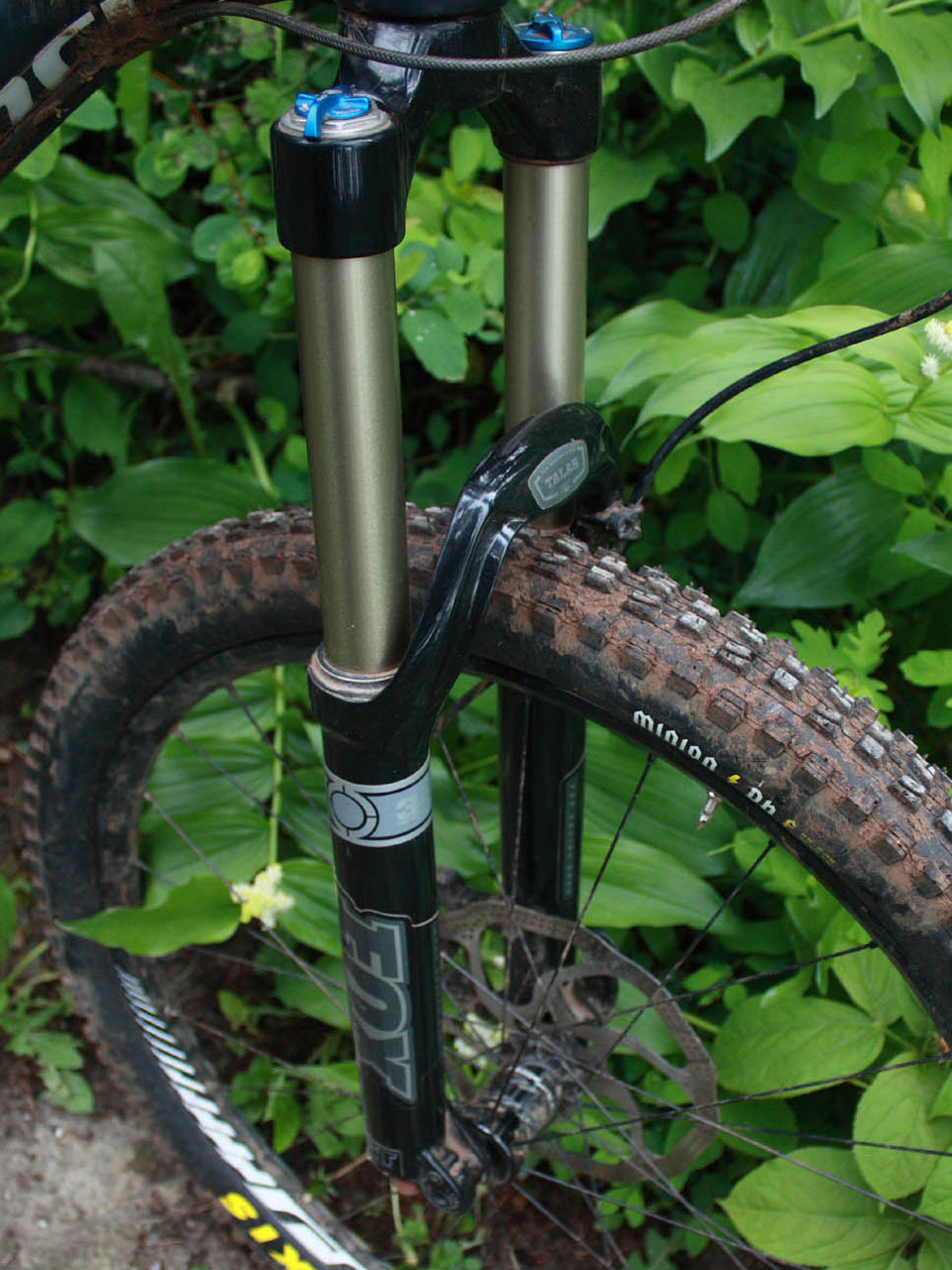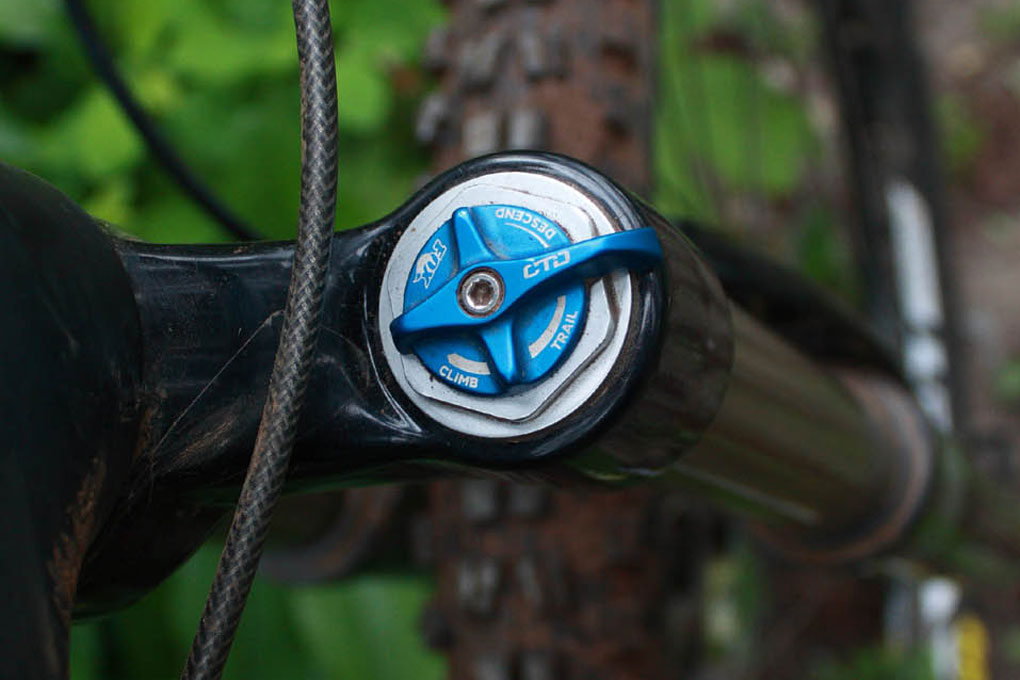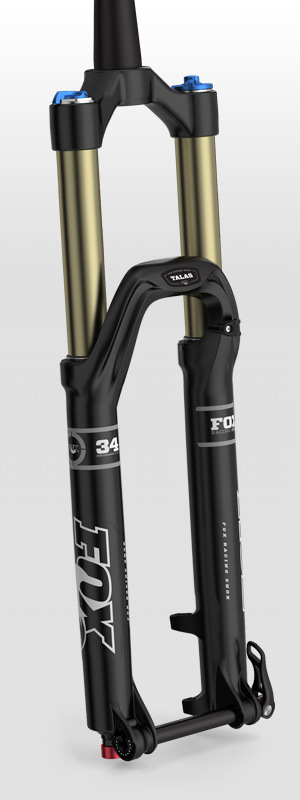Tapered steerer
15mm through axle
160 / 130mm externally adjustable travel
Weight: 4.45 lbs
Intended Use: Trail / All Mountain / whatever you call riding that involves 160mm travel forks.
Attached to: Specialized Enduro Expert Carbon
Rider: 5’9” 150 lbs.
Test Locations: Mostly Whitefish, Montana, but with some time in Moab, Sedona, Hurricane, Hood River,
Days Ridden: ~40 days
Since the Fox 34 seems to be the current standard suspension on higher end, ~6” trail bikes, we felt that a review of the basic design of the fork and its internals was in order. Furthermore, as of 2013, all 34 and 32mm Fox forks include their new CTD damper system, so all the more reason to take a close look at the CTD.
The Evolution of the Fox 34 Chassis
The 34 chassis is something that Fox introduced a couple of years ago to fit the growing market for longer-travel-yet-lightweight suspension. At 4.45 lbs, it comes in about where you’d expect for a fork like this—it’s lighter than the Fox 36 (4.83 lbs) and the Rockshox Lyrik (4.94 lbs), but heavier than the shorter-travel options (e.g., the Rockshox Revelation, 3.6 lbs; Pike, 4.05 lbs; or the Fox 32 series, 3.6 lbs, depending on options).

It’s not surprising, then, that the 34 series has been an appealing choice for a lot of bike manufacturers and comes spec’d on quite a few longer-travel bikes—they hit the right mark in terms of weight and travel that most popular bikes out there are looking for. The 34s are also available to fit all of the major wheel sizes: 26”, 27.5”, and 29”.
My particular fork, which came stock on my Specialized Enduro Expert (review forthcoming), is the 26” model and has the Talas travel adjustment, which allows me to drop the fork from 160mm of travel to 130mm. Mine also has a tapered aluminum steerer tube that’s increasingly standard these days, and a 15mm through axle. The brake mount is “post” style, so depending on your rotor size, you may be able to get away without a brake adaptor.
For whatever reason, Specialized did not choose to go with the version of the fork with Kashima coating on the legs, but Kashima is available on this fork.
Stiffness
I found the 34 chassis to be reasonably stiff, but I noticed some flex under heavy braking and on particularly chundery trails. While bigger guys may have more of a problem with this, I ultimately didn’t have any particular quarrels with the stiffness. The 34 lands about where one would expect; it’s not quite as stiff as the 35mm (Lyrik) or Fox 36 options, but it’s pretty close. It’s quite a bit stiffer than the 32mm forks that I’ve ridden.
The 15mm Through Axle
The 34 chassis only comes with a 15mm through axle option. While I found the 15mm axle to work fine from a performance standpoint, this particular design choice irks me. There is a very real chance that a 160mm-travel fork is going to get used for some light duty downhilling, and many of the more downhill-oriented wheelsets are not available in a 15mm configuration.
There’s no denying that the 15mm axle will ultimately make the fork lighter (by a small amount) and the accompanying hub lighter (by a more significant amount), but the loss of wheel options with this fork is disappointing to me.
It seems that by choosing the 15mm axle, Fox is trying to narrow the intended use of this fork, i.e., the 32 series is for XC, the 34 series is for longer-travel trail bikes, and the 36 series is for freeride. But the line between a longer-travel trail bike and a freeride bike is pretty blurry these days. It’s blurry enough that marketing folks dreamt up the “all-mountain” category to try to pigeonhole these bikes, but even that is pretty susceptible to interpretation. The fact of the matter is that as bikes become more capable, one steed can serve XC duties one day and light duty DH the next. By limiting wheel options with the 15mm axle, I think Fox is inhibiting the potential uses of this fork.
Travel Adjustment
The Talas feature has been around on Fox forks for quite some time, and it works well. I’ll admit that it’s not something that I use all that often, but for sustained steep climbs, it can really help. The Talas system on my fork has worked flawlessly from the start, so no complaints there.
The Talas system does, however, add a bit of complexity to the fork as well as some extra internal seals, which ultimately make it feel less supple than non-travel adjustable forks. I find this to be a relatively minor but noticeable difference. So if you are going for no-holds-barred suspension performance and don’t care about climbing lots of steep hills, the fixed-travel versions are probably a better bet.
CTD Damper
The most notable feature of the 34 is Fox’s new CTD damper system, which as of 2013, all Fox 34 forks have. (So do all the 32mm forks.) More details on that in a second, but first it’s worth noting that the CTD damper uses Fox’s well-established “FIT” technology. This essentially means that the fork’s oil is wrapped up in a rubber booty inside the fork. This keeps air bubbles from getting into the suspension oil and screwing with the suspension performance, while at the same time gives the oil someplace to go as it’s displaced from the fork compressing.
Fox uses the FIT system in many of its forks; it works well and is user serviceable for those so inclined.
Getting back to the CTD damper, Fox has incorporated it into most of their uphill friendly forks and rear shocks, as well as their D.O.S.S. seatpost. Depending on whom you talk to, the CTD moniker either stands for “Climb, Trail, Descend” or “Can’t Tune, Dammit.”
The basic premise is that at the top (or bottom) of the climb, you simply set everything on your bike to the appropriate letter. Going uphill? Put everything in Climb. Traversing rolling terrain? Put it in Trail. Getting rad on the downhill? Go for Descend.

The fork’s three position settings are fairly logical: “Climb” is firm—not quite locked out, but definitely not supple. “Trail” is intended to be a middle-ground setting to minimize bobbing while still offering some bump compliance. “Descend” is designed to be geared solely toward supple suspension with less regard for efficiency. How those settings actually work in the real world, however, is more of a problem.
Fox’s reasoning behind the CTD damper is fairly clear: the average suspension user isn’t dialing in their suspension properly, and is getting confused by all the knobs. Thus, Fox has given us three simple, well-labeled options. Here’s my review of each…


I’m pleased to report that the Fox 2014 CTD damper is not quite the over – underdamped spiking piece of crap that is the lamentable 2013 dungheap. Sorry to 2013 CTD buyers. who got the raw end of the deal on this one.
There’s no denying Fox took a pretty big step backwards with the CTD
Thanks for the frank review
Interesting that your OEM model came without Trail Adjust. I was unaware that Fox was offering CTD forks without it.
It’s my understanding that Fox just changed the damping for 2014 – the Trail Adjust was available on 2013 models. My fork, which was a take-off from a Yeti SB-66 has it and AFAIK is a 2013.
From the mixed information I can find, it looks like some of the 2013 CTD forks had Trail Adjust and some didn’t, so it appears that you’re right; trail adjust is not a new thing for 2014.
Not all 2014 forks have it though; based on Fox’s website, you get a choice of either a remote (you gain a handlebar mounted switch but lose the external trail adjust), or the external trail adjust with no remote.
I have no idea what OEM models will be offered. Specialized has a long history of working with Fox to come up with “special” suspension, so there’s a possibility that the lack of a trail adjust on my fork is just a Specialized thing.
Myself and a few friends all have 2013 CTD forks (or is it Forx?) with the Trail Adjust feature. This goes a long way in the tunability of the fork, and I’ve found a careful balance of air pressure and the Trail “3” setting has yielded the best results for my style of riding. The Descend mode is straight garbage for me—it requires so much spring to keep from blowing through the travel there’s no trail feel left. Do I lament the absence of “simpler and yet more adjustable” HSC and LSC adjustments? Yes. Does mine still spike or bottom out occasionally? Yes, but after riding it for a year or more, at least it seems predictable when it will behave “poorly”. Do I think CTD is a step backward? No, but I think it’s a solution to a problem that doesn’t exist… with people that know how to adjust their suspension. For the 87% of riders who don’t, it could be the solution they’ve been needing all along.
An additional comment for clarification: all of the 2013 CTD forks I have encountered are the Float model and do NOT have the TALAS adjustment.
The guys at the LBS told me that the 2014 Fox 32 is going to be more progressive, but will continue to have the CTD. Any updates on your end regarding next years model? Any plans on reviewing the 20124s when they come out ( I heard June of this year). Thanks
You LBS is correct; the 2014 CTD forks (both the 32’s and 34’s) have revised dampers. The basic CTD system is the same, but supposedly they’ve fixed many of the issues I complained of. I haven’t had a chance to ride one yet, but I’m hoping to get my hands on one sometime this summer. I think it’s safe to say that the 2014 models will be better, but the jury is still out on whether they’re actually good.
Regarding the 2014 models, I’ve heard the all new talas cartridge will be easily and cheaply retrofit table into 2013 talas forks. Seems like, if you want travel adjust, picking up a 2013 talas on sale could be a smart move.
Hey Noah, when do you think you guys will be able to do an eval of this versus the 2014 and the new Pike? Really curious how the 2014 and the Pike will stack up next to each other as I’m not overly stoked with my 2013 32.
Hey Jeff – agreed that a 2014 CTD vs. Pike comparison is in order. Apparently the new CTD is *better* and I hear rumors that the Pike is pretty sweet. I’m not sure what the exact timeline for taking a look at those will be, but to get a thorough review, we usually like to spend at least a month or so on the fork. Check back in from time to time, and hopefully we’ll have some updates on this front!
Will do Noah, thanks for the info. I’m hoping to see both of them out at the 2014 Giant launch in a few weeks but you never know what the new bikes will be kitted out with.